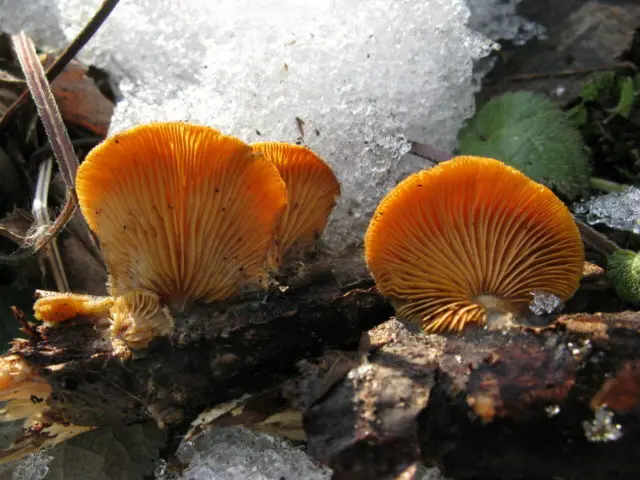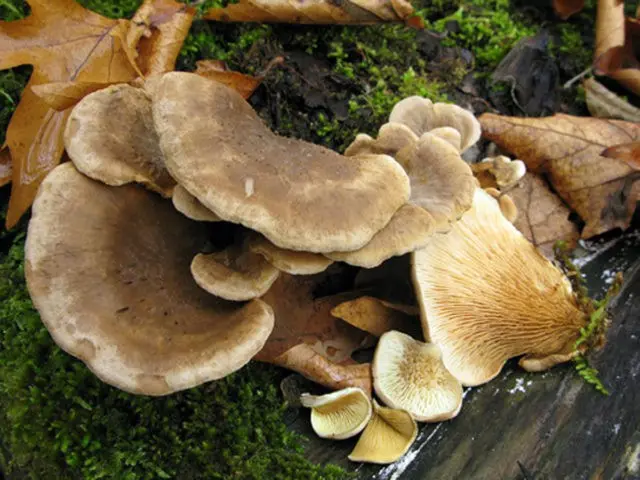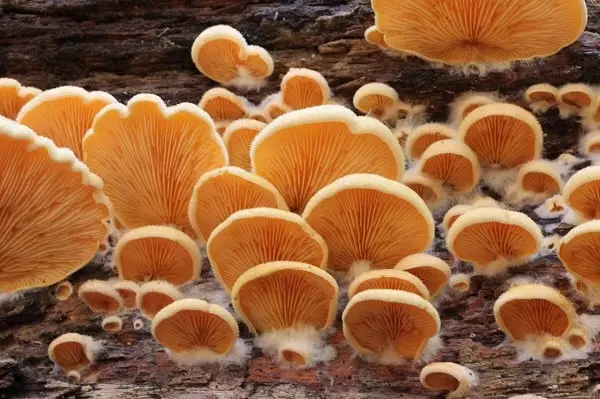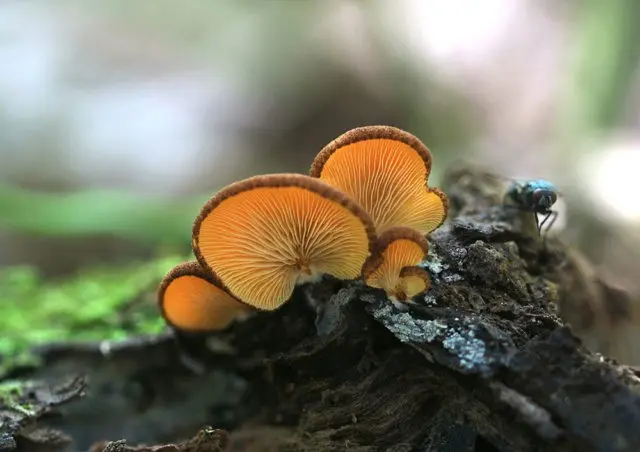Contents
Orange oyster mushroom belongs to the Ryadovkovye family, the genus Phyllotopsis. Other names – Phyllotopsis nest-shaped / nest-shaped. It is a sessile stemless mushroom that grows on trees. The Latin name for orange oyster mushroom is phyllotopsis nidulans.
Where does orange oyster mushroom grow?
The fungus is quite rare. Distributed in the temperate climate zone of North America and Europe, including Our Country. Settles on stumps, deadwood, branches of trees – both deciduous and coniferous. It grows in small groups, sometimes singly. It bears fruit in autumn (September-November), in warmer climates and in winter.
What does orange oyster mushroom look like?
It differs from other oyster mushrooms in its noticeable beautiful fruiting bodies with bright colors.
The hat in diameter is from 2 to 8 cm. It is flat-convex, fan-shaped, pubescent, grows sideways or top to the trunk. In young specimens, the edge is turned up, in old specimens it is lowered, sometimes wavy. The color is orange or orange-yellow, darker in the middle, with concentric, rather diffuse banding. The surface is smooth. Mushrooms that survived the winter look faded.
The flesh is light orange in color, rather thin, dense, rather hard.
The spore-bearing layer consists of frequent, wide orange or dark orange plates that diverge from the base. The powder is pale pink or brownish-pinkish. Spores are smooth, oblong, elliptical in shape.
Phyllotopsis nest-shaped does not have a leg.

Phyllotopsis nest-shaped in the spring forest
Is it possible to eat phyllotopsis nest-shaped
It belongs to conditionally edible, but is practically not eaten because of the rigidity, bad smell and unpleasant bitter taste. Some mushroom pickers believe that young specimens are quite suitable for use in cooking. It belongs to the fourth taste category.
Taste characteristics depend on the substrate and age. The smell has been described as strong, fruity, or melon to the point of rot. The taste of the young is soft, the mature one is putrid.
False doubles
Despite the fact that orange oyster mushrooms are difficult to confuse with other mushrooms, there are several similar species.
Tapinella panusoid. The main difference is that the fruiting body is brown or brownish. The flesh is quite thick, yellowish-creamy or light brown, darkens when cut, smells like resin or pine needles. The cap size is from 2 to 12 cm, the surface is velvety, light ocher, yellow-brown, the edge is wavy, serrated, uneven. Its shape is tongue-shaped, flat-shaped, dome-shaped, fan-shaped. The plates are frequent, narrow, cream, brownish-orange or yellow-orange. Most specimens lack a stalk, but some have one, short and thickened. The fungus is often found in Our Country. It is inedible, slightly poisonous.

Tapinella panus is easy to distinguish by the color of the fruiting body and the thickness of the pulp.
Phyllotopsis is weakly nesting. In these mushrooms, the color of the fruiting bodies is brighter, the flesh is thinner, the plates are rare and narrow.

Grows in smaller groups, non-edible species
Crepidote saffron lamellar. It differs from oyster mushrooms in orange brownish scales on the surface of the fruiting body. An inedible mushroom with a sessile cap without a stem is attached to the place of growth at the top or side edge. The pulp is odorless, thin, white. A hat with a wrapped even edge, its size is from 1 to 5 cm, the shape is semicircular, kidney-shaped. Its light skin is covered with small scales of light brown or yellowish-orange color. The plates are frequent, narrow, radially diverging, pale orange, yellow, apricot, with a lighter edge. It grows on the remains of deciduous trees (linden, oak, beech, maple, poplar). Found in Europe, Asia, Central and North America.

Crepidote saffron lamellar give out noticeable brownish scales
Phyllotopsis nest-shaped is a bit like oyster mushroom late, or alder. The difference is in the presence of a short stem and the color of the cap. It can be greenish-brown, olive-yellow, olive, gray-lilac, pearl. The mushroom is conditionally edible, requires mandatory heat treatment.

Late oyster mushroom is distinguished by a layer of pulp under the skin of the cap, resembling gelatin
Rules for collection and use
Experienced mushroom pickers recommend picking only young specimens, which are not yet too hard and have not acquired an unpleasant smell and taste. The collection begins in early autumn and can continue even in the cold season. Looking for orange oyster mushrooms is very simple – they can be seen from afar, especially in winter.
Conclusion
Oyster mushroom is rarely eaten. One of the most beautiful mushrooms can be used in landscape design, to decorate the yard or garden. To do this, it is necessary to bring mycelium onto tree trunks and stumps. They look especially impressive in winter.









